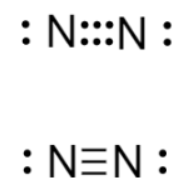Contraction of the external intercostal muscles causes which of the following to occur?
A. The diaphragm moves downward
B. The rib cage is compressed
C. The thoracic cavity volume decreases
D. The ribs and sternum move upward
The intercostal muscles are muscles are located along the ribs. The intercostal muscles assist in respiration mechanically. This allows the expansion and contraction of the thorax.
Contraction of the external intercostal muscle causes the ribs and sternum move upward.
Therefore, the Correct Answer is D.
More Questions on TEAS 7 Science
-
Q #1: Nitrogen gas is an extremely stable molecule because its structure contains which of the following?
A. Resonance bonds
B. Ionic bonds
C. Triple covalent bonds
D. Hydrogen bonds
Answer Explanation
The Lewis structure of nitrogen gas is shown below. Triple bonds are stronger than double or single bonds. Therefore, we can infer that the triple bond between the two nitrogen atoms makes nitrogen gas more stable.

-
Q #2: Which of the following best describes veins?
A. thick walled, small lumens, low pressure, lack valves
B. thin walled, large lumens, low pressure, have valves
C. thin walled, small lumens, high pressure, have valves
D. thick walled, large lumens, high pressure, lack valves
Answer Explanation
-
Q #3: Which of the following is the atomic number of an atom that has 12 protons and 12 neutrons?
A. 144
B. 12
C. 24
D. 1
Answer Explanation
elements are arranged on the periodic table based on their atomic number. This identity is critical in evaluating the chemical families of elements in chemistry. Atoms are made of protons, neutrons, and electrons. Protons and neutrons are found in the nucleus while electrons are found outside the nucleus of the atom. It is the number of protons of an atom that gives its atomic number. Therefore, an atom with 12 protons has an atomic number of 12.
-
Q #4: A myocardial infarction affects which of the following blood vessels of the heart?
A. Aorta
B. Vena cava
C. Pulmonary
D. Coronary
Answer Explanation
A myocardial infarction refers to heart attack, which result from blockage of blood flowing into the heart.
Blocking is caused by the deposition of fat or cholesterol that forms plaque on the surface of coronary arteries, which supply blood to the heart.
-
Q #5: Which of the following indicates the function of sodium bicarbonate released by the pancreas?
A. Sodium bicarbonate inhibits peristalsis
B. Sodium bicarbonate is a protease that digests carbohydrates
C. Sodium bicarbonate stimulates the pyloric sphincter
D. Sodium bicarbonate neutralizes the acidity of chyme
Answer Explanation
Sodium bicarbonate is an alkaline solution, which is released by the pancreas. Chyme is acidic coming from the stomach is neutralized by sodium bicarbonate to protect the duodenum.
-
Q #6: The Life Cycle of HIV Which of the following allows the AIDS virus, which contains RNA, to insert viral DNA into the DNA of a host T-cell after the AIDS virus enters the cell?
A. Receptor proteins located on the surface of the virus
B. The protein that makes up the capsid of the virus
C. Reverse transcriptase, an enzyme encoded by the virus
D. The phospholipids found on the envelope of the virus
Answer Explanation
The AIDS virus (HIV virus) is Class VI or Group VI in the Baltimore Classification. Based on the Baltimore Classification, this specifically involves the reverse transcriptase enzyme and it is encoded by the virus.
This is the enzyme that will produce DNA molecules from the viral RNA. This is the mechanism involved where it will use the reverse transcriptase enzyme to insert viral DNA into the genetic material of the host cell.
-
Q #7: Which of the following vessels carries oxygenated blood?
A. Inferior vena cava
B. Pulmonary vein
C. Pulmonary artery
D. Superior vena cava
Answer Explanation
Pulmonary vein carries oxygenated blood from the lungs to the heart. Pulmonary artery carries deoxygenated blood from the heart to the lungs.
Superior and inferior vena cava bring in deoxygenated blood from all other parts of the body to the heart. -
Q #8: Which of the following best describes the result of using a catalyst in a chemical reaction?
A. A more desirable product is often formed
B. The reaction is completed in a shorter amount of time
C. The yield of product is increased
D. A greater amount of energy is released by the reaction
Answer Explanation
A catalyst is substance that speeds up the rate of converting reactants to products. They do by decreasing the activation energy of a reaction. If a catalyst increases the rate of reaction, then it means that the reaction takes a smaller time to come into completion.
Catalysts can be metals, ions or biological also known as enzymes. Catalysts are not consumed when the reaction is taking place. -
Q #9: If a portion of strand of DNA bases reads 5’ AGCTAGCGT 3’, what would the sequence of bases on the complementary strand read?
A. 5’ UCGAUCGCA 3’
B. 3’ TCGATCGCA 5’
C. 5’ TCGUTCGCU 3’
D. 3’ AGCTAGCGT 5’
Answer Explanation
The complimentary base pairing of DNA states that A pairs with T while C pairs with G. From the give sequence, the complimentary DNA strand will be 3’ TCGATCGCA 5’
-
Q #10: Practice Question An atom has 14 protons and 20 neutrons. What is its atomic number?
A. 20
B. 17
C. 10
D. 14
Answer Explanation
Free Access on TEAS 7 Exams and Study Notes
- Access to all TEAS 7 Exams
- Performance Tracking and Analysis
- Well Documented and Explained Questions and Answers
- 2000+ Questions and Correct Answers: Answers Well Explained
- Libary of Detailed StudyNotes
- Topical Questions and Answers on Examinable topics
TEAS 7 Exams (Q&A)
TEAS 7 Study Notes
TEAS 7 Topical Tests

TEAS 7 Study Guides
Quick Links
Refer a Friend
Refer a friend and claim free unlimited access

© 2024 ExamGates Made with by ExamGates
